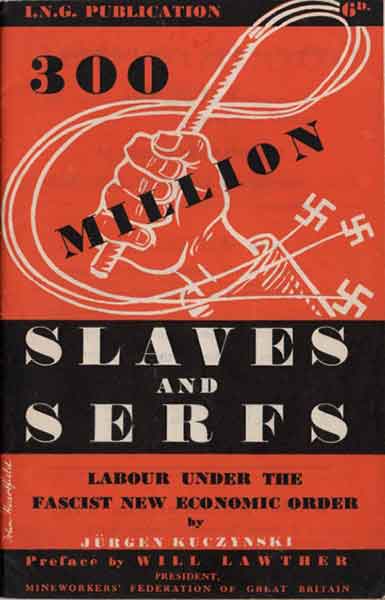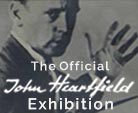300 Million Slaves and Serfs! Workers Under Fascism | John Heartfield London Book Cover 1942
300 MILLION SLAVES AND SERFS. LABOUR UNDER THE FASCIST NEW ECONOMIC ORDER
by Jürgen Kuczynski with a preface by Will Lawther
John Heartfield London Book Jacket Design, 1942
An Andrea Hofmann Commentary

A lot has been written about Heartfield’s Dada period, his work for the AIZ and later the Volks-Illustrierte. Considerably less attention has been paid to his work in England. This is unfortunate, as Heartfield created interesting works while in England in spite of the strain of his living conditions and uncertain future.
In fact, Heatfield’s twelve-year stay in England is often more or less ignored, and at times even considered unproductive and uninteresting. Actually, he worked for renowned publishers such as Lindsay Drummond and Penguin.
This book cover is one of several works Heartfield created for ING-Publications. I.N.G. stands for Inside Nazi Germany. ING-Publications published books and brochures. It was a joint venture of the Friends of the German People’s Front in London and the Committee of the German Opposition. Heartfield created at least twenty works for this publisher.
Cracking The Whip
On this cover we see a hand cracking a whip. The thong of the whip has the form of a G clef. At the end of the whip, the so-called cracker, we see swastikas.
At a first glance this work looks quite simple. But, a lot of thought went into it.
The G clef
Heartfield liked to use generally understandable symbolism, and it can be here as well. A G clef is a musical symbol that many people were familiar with it.
The German word for clef is „Notenschlüssel“ which literally translates to key to the notes. The G clef envelops and points out the “G” note. This might be a dig at two major Nazis, Goebbels and Göring.
Goebbels was a German Nazi leader. He was Reich Minister of Public Enlightenment and Propaganda from 1933 to 1945. He was a stark anti-Semite, advocated for the extermination of the Jews in the Holocaust, and promoted the idea of the German master race.
Göring was also a major Nazi leader. He founded the Gestapo and set up concentration camps in order to get rid of opponents as well as racial and religious ‘undesirables.’ He held many political posts.
Among other terrible things, Göring was responsible for the Four Year Plan, which aimed at getting the economy ready for war. This included occupy territories. Cartoonists often mocked Göring and his stout figure, which stood in stark contrast to his preaching austerity. Heartfield created many anti-Göring montages for the AIZ and the Volks-Illlustrierte. For example, Göring’s famous remark “Ore has always made an empire strong, butter and lard have made a people fat at most” prompted Heartfield’s montage Hurrah, There is no butter left!
Hurrah! There’s No Butter Left
He who pays the piper calls the tune
Heartfield also liked alluding to proverbs. This book cover brings the German proverb “Wes Brot ich ess, des Lied ich sing” to mind. Literally it translates as “whose bread I eat, whose song I sing”, which is the equivalent of the English proverb “don’t quarrel with your bread and butter.”
A clef is a witty visualization of this proverb as it alludes to the fact that a clef specifies the pitch of notes and defines the other notes in the system. Similarly, the economic order determines the ‘pitch’ and position of workers.
Alluding to the proverb, Heartfield visually stresses the interdependence between the economic and the political system and toys with the title of the book 300 Million Slaves and Serfs. Labour under the Fascist New Economic Order.
To catch our attention, Heartfield also used easy-to-read fonts. His background and text color contrast well which makes them light on the eye and attracts us to the book.
At the same time, Heartfield used different fonts and mashed the figures of the title with the visual image of the hand cracking the whip. Thereby, he highlighted the enormity of the number of people affected.
Whip Details
On top of that, Heartfield used graphic visual symbols. A whip is an instrument of communication. It symbolizes a hierarchical system in which communication is one-sided and disobedience fatal. Automatically we know that opposition has no voice in this system. This included unions that were taken over by the Nazis as soon as they gained power.
Many cartoonists used whips as a symbol for Nazi terror such as Edmund Gale, Irwin D Hoffman, Gordon Minhinnick and Carl Rose. Heartfield might have known some of these cartoons. They were part of the cultural discourse of his time. We know Heartfield was a great fan of David Low. He might have followed other cartoonists as well. After all, nobody is an island.
Context
I.N.G. Publications was a joint venture of the Friends of the German People’s Front in London and the Committee of the German Opposition. The aims and policy of the publishers of I.N.G. Publications were:
1. To keep the British public informed about the situation of the people inside Nazi Germany in particular the German anti-Fascist underground movement.
2. To provide reliable information and skilled personnel to assist in strengthening the broadcasts and all forms of propaganda to Germany.
3. To publish from time to time bulletins, leaflets, pamphlets and reports for the press.
4. To work in closest collaboration with all the progressive forces in great Britain.
The Writers
Will Lawther, who wrote the preface, was the president of the Mineworkers’ Federation of Great Britain at the time of the publication.
Jürgen Kuczynski was a renowned German-Jewish economist and statistician who became an advisor to East German leaders after the war. Heartfield had already created the book cover for Kuczynski’s book Freedom Calling. The Story of the Secret German Radio.
Freedom Calling. The Story of the Secret German Radio
Like The Story of the Secret German Radio, 300 Million Slaves and Serfs is a very interesting read. In this book Kuczynski succinctly describes the divide and rule tactics of the Nazis, their economic repercussions and their effect on the people.
Kuczynski’s analysis shows that certain big business profited immensely from the Nazi economic order. Apart from that, he described in what way different occupied countries played different roles for the Nazi economy and the war effort.
He also explained the various effects on the treatment of the respective population of the countries concerned and pointed out how these different policies were justified by corresponding racial theories. Polish people, for example, were declared subhuman while Danish people were considered ‘semi-Aryan.’
On the other hand, Kuczynski also stresses that workers resisted the Nazi regime and encouraged any form of resistance and acts of solidarity. So, the book is not only an analysis of Nazi terror but also an appeal to stand up for human rights.

